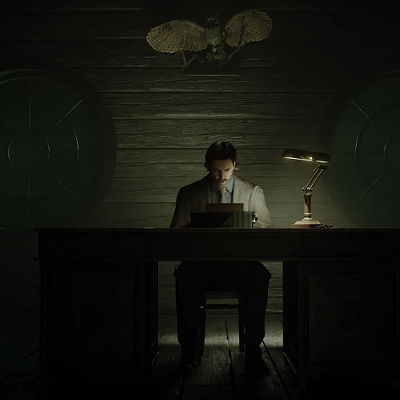To tour the galleries on Friday night, we started at William Reaves Fine Art, where they are taking a break from the regular focus on Texas Modernists, primarily from the last century, to make room for a once-a-year show of paintings by contemporary artists whose subjects are the environment and culture of Texas. These included Texas flags painted on the sides of barns, fields of bluebonnets, tire-ruts, big skies lit dramatically by setting suns, gas stations, oil derricks, and Audubon-inspired bird cataloguing, with examples of each from multiple artists. An enthusiastic crowd came to survey works of mainly ornamental and often sentimental appeal.
A sort of theme for the night was set by Randy Bacon's and Pat Gabriel's landscapes with power lines. These lines in the sky are disruptive and evocative, an airborne tangle at about the same height as the trees, but their electric presence can't be reconciled with the earth.
Debbie Stevens paintings stood apart in their large-scale appreciation of watery environments, the sky reflected like crystals in shorelines and marshy areas where her subjects - roseate spoonbills, mallards, and terns - make their way.
At Moody Gallery, Randy Twaddle's works in ink and coffee were all about power lines, this time divorced from their settings and make into abstractions, continuing a more-than-10-years-old obsession with electrical transformers and cables. Many in Houston know Twaddle through his work on "Houston It's Worth It", a crowd-sourced campaign and book featuring much in the way of lighting and power. Given Twaddle's design sensibilities - he installed wallpaper in one corner of the gallery for this show, a knot of lines as its motif - it is no surprise that previous incarnations of this work have been made into classy rugs last year.
Just about four years old, little Nola Nelson could identify which were the paintings that included tawny washes of coffee, which Twaddle sometimes laid down in splashes behind the more defined and figurative silhouettes of the power lines. Nola enjoys drawing with markers and paints, but when I asked if she'd like to try painting with coffee, she pointedly refused, shaking her head.
McMurtrey Gallery had new works by Robert Jessup that frankly surprised the folks who thought they already knew Jessup's style and subjects. He's pursuing new directions in these highly kinetic paintings and drawings. The paintings in particular are thick in paint applied in energetic strokes and broad swipes of plain color, interrupted here and there by contours of hidden figures, like a faces and hands. Jessup describes a rather physically demanding practice behind these paintings, "equal parts deliberation and desperation," as he figures out "how to resolve an image." The results, he says, look nothing like what start out with.
McMurtrey Gallery also recently opened its microgallery, this time featuring works by Houstonian Howard Sherman, whose thickly contoured and strikingly colored paintings were dominated by creaturely figures telling stories about heartache and revenge. Maybe Sherman would not see it the way I have. The titles of his paintings - "The Theocrat," and "Wanton Carnality" for example - demonstrate undeniable narrative potency. They are fitting companions for Jessup's works, also deeply invested in storytelling.
Sabine Stromeyer's richly textured works at Thornwood Gallery charmed her crowd with fuzzy stones, gold leaf, gobs of paint, and wirey green moss. The smaller works in particular, employing foam insulation for pipes, or Styrofoam peanuts, or sponges, made a strong impression.
In the Heights, G Gallery was showing works by students and faculty at the University of Houston's print studio, which is as fun and off-balance as you might expect of a show of student work. The real treasure of a show like this is that there is so much of it, featuring a huge variety of approach, style, and message. Steve and Sharon Weiss have for years enjoyed seeing student works like this, and are proud of the chance to support new artists. They purchased a hilarious work by CJ Soukup, "Baddest Housewife," because of its humor. It shows a smiling 1950s woman in a full apron, her whisk in her bowl. The words next to her head say, "Don't like the taste? Cook your own FUCKING food!"





